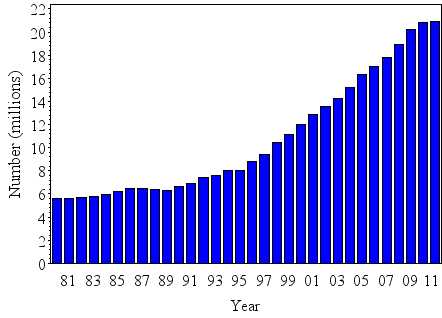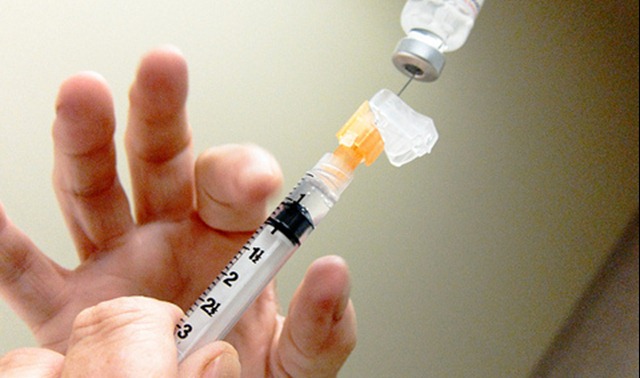Even if they’re still within the normal range, higher glycated hemoglobin (HbA1c) levels may be associated with poorer performance on certain cognitive tests and with differences in hippocampal structure, German researchers found. Among healthy middle-age and older adults with mean HbA1c levels of 5.8%, each standard deviation increase in HbA1c was associated with significant declines in delayed recall, learning ability, and memory consolidation… They added that “lifestyle strategies” to achieve strict glucose control could prevent age-related cognitive decline, even in individuals with HbA1c levels currently considered normal — a hypothesis that should be tested in future trials, they noted.
Bisphenol A (BPA) is a known endocrine disruptor that hijacks the normal responses of hormones. Yet, traditional toxicology studies indicate that only very high doses of this chemical affect exposed animals—doses as high as 50 mg/kg/day. For the past decade, scientists have used modern scientific techniques to probe the effects of BPA on numerous endpoints that are not examined in those traditional toxicology studies. Examining these non-traditional endpoints reveal a very different story. Because of increased understanding of the mechanisms by which hormones and chemicals that mimic hormones work, it has recently become clear that endocrine disruptors need to be studied at much lower doses.
The FDA has taken the first step toward eliminating the use of partially hydrogenated oils — the main dietary source of artificial trans fat — in processed foods, the agency announced in a notice scheduled for publication in the Federal Register on Friday.
On the basis of a review of scientific evidence and findings from expert panels, the agency made a preliminary determination that the oils “are not generally recognized as safe for use in food” and should be eliminated.
The world is losing the battle against diabetes as the number of people estimated to be living with the disease soars to a new record of 382 million this year, medical experts said on Thursday. The vast majority have type 2 diabetes – the kind linked to obesity and lack of exercise – and the epidemic is spreading as more people in the developing world adopt Western, urban lifestyles. The latest estimate from the International Diabetes Federation is equivalent to a global prevalence rate of 8.4 percent of the adult population and compares to 371 million cases in 2012. By 2035, the organization predicts the number of cases will have soared by 55 percent to 592 million. Deaths from the disease are now running at 5.1 million a year or one every six seconds. People with diabetes have inadequate blood sugar control, which can lead to a range of dangerous complications, including damage to the eyes, kidneys and heart. If left untreated, it can result in premature death.
Source: Reuters
The Food and Drug Administration warned on Tuesday of a counterfeit dietary supplement for male sexual enhancement that could be particularly harmful to patients with diabetes, high blood pressure, high cholesterol and heart disease. In a safety warning posted on its website, the FDA said the fake product is represented as “ExtenZe Maximum Strength” and looks similar to the actual product, ExtenZe, which is made by Monrovia, California-based Biotab Nutraceuticals Inc. The FDA said its analysis showed that the counterfeit ExtenZe contains sildenafil, an active ingredient in various FDA-approved prescription medicines, including Pfizer’s Viagra, for erectile dysfunction… Sildenafil may interact with nitrates — found in some prescription drugs and often taken by men with diabetes, high blood pressure, high cholesterol, or heart disease — and could lower blood pressure to dangerous levels, the FDA said.
Source: Reuters
Adopting a habit of “intermittent fasting” that involves foregoing food every other day may eventually lead to weight loss and improve cognition in heavier patients, researchers reported here. In a single-center, randomized, pilot study, patients who fasted completely every other day lost about the same amount of weight over 2 months as those who didn’t fast at all… But at 6 months, after patients were technically off the intervention, those who had the initial “intermittent fasting” intervention had greater weight loss and greater improvements in cognitive function than those on a standard diet, Donahoo reported… In an earlier paper, Mattson wrote that intermittent fasting is consistent with the way humans evolved to eat. “From an evolutionary perspective, intermittent fasting is normal, and eating 3 meals a day plus snacks is abnormal. Going without food for most of the day or even for several days is a challenge that we are very capable of meeting,” he stated.
Nut consumption has long been linked to healthy lifestyles. Now, a study in the New England Journal of Medicine extends the finding and demonstrates a strong association with improved mortality. Ying Bao and colleagues examined data from nearly 120,000 people enrolled in the Nurses’ Health Study and the Health Professionals Follow-up Study to assess the relationship of nut consumption and mortality. With over 3 million person-years of follow-up, the investigators found a strong inverse correlation between the frequency of nut consumption and mortality, after adjusting for other risk factors.
Energy drinks packed with caffeine can change the way the heart beats, researchers warn. The team from the University of Bonn in Germany imaged the hearts of 17 people an hour after they had an energy drink. The study showed contractions were more forceful after the drink. The team told the annual meeting of the Radiological Society of North America that children and people with some health conditions should avoid the drinks. They showed the chamber of the heart that pumps blood around the body, the left ventricle, was contracting harder an hour after the energy drink was taken than at the start of the study. Dr Dorner added: “We’ve shown that energy drink consumption has a short-term impact on cardiac contractility. “We don’t know exactly how or if this greater contractility of the heart impacts daily activities or athletic performance.” The impact on people with heart disease is also unknown. However, the research team advises that children and people with an irregular heartbeat should avoid the drinks.
Source: BBC
Walking, fast or slow, is wonderful exercise. But now a first-of-its-kind study shows that to get the most health benefits from walking, many of us need to pick up the pace.
The findings stem from a new analysis of the National Walkers’ Health Study, a large database of information maintained at the Lawrence Berkeley National Laboratory about thousands of middle-age men and women who walk regularly for exercise. Recruited beginning in 1998 at walking events and from lists of subscribers to walking-related publications, these volunteers filled out a lengthy survey about their typical walking distance and pace, as well as their health history and habits.
As most of us would likely guess, walking is the most popular physical activity in America. But people who walk for exercise do so at wildly varying speeds and intensities. Some stroll at a leisurely 2 miles per hour, which is low-intensity exercise. Others zip along at twice that pace or better, resulting in a sweatier workout.
Exercise guidelines generally suggest that for health purposes, people should engage in 30 minutes of moderate-intensity activity most days of the week. For walkers, a moderately intense pace would probably be about 15 or 16 minutes per mile.
It has generally been assumed that if people walk more slowly but expend the same total energy as brisk walkers — meaning that they spend more time walking — they should gain the same health benefits. But few large-scale studies have directly compared the impact of moderate- and light-intensity walking, especially in terms of longevity.
To do so, Paul T. Williams, a statistician at Lawrence Berkeley National Laboratory, gathered data about 7,374 male and 31,607 female participants from the walkers’ health study, who represented almost every speed of fitness walker, from sluggish to swift. His findings were published online this month in PLoS One.
Dr. Williams divided participants into four numerically equal categories, based on their normal pace. Those in Category 1, the fleetest, averaged less than 13.5 minutes per mile, putting them on the cusp of jogging, while those in Category 4, the slowest, strolled at a relatively dilatory 17 minutes or more per mile. The majority of the walkers in this group in fact required at least 20 minutes to complete a mile, and many had a pace of 25 minutes or more per mile. (Interestingly, on average, female walkers were faster than men in all of the categories.)
Next, Dr. Williams cross-referenced his data against that in the essential if somewhat ghoulish National Death Index to determine which of the almost 39,000 walkers had died in the decade or so since they had joined the survey and from what.
It turned out that nearly 2,000 of the walkers had died. More telling, these deaths disproportionately were clustered among the slowest walkers. Those in Category 4 were about 18 percent more likely to have died from any cause than those in the other three categories and were particularly vulnerable to deaths from heart disease and dementia.
Unexpectedly, the death rate remained high among the slowest walkers, even if they met or exceeded the standard exercise guidelines and expended as much energy per day as someone walking briskly for 30 minutes. This effect was most pronounced among the slowest of the slow walkers, whose pace was 24 minutes per mile or higher. They were 44 percent more likely to have died than walkers who moved faster, even if they met the exercise guidelines.
One important inference of these statistics is that intensity matters, if you are walking for health. “Our results do suggest that there is a significant health benefit to pursuing a faster pace,” Dr. Williams said. Pushing your body, he said, appears to cause favorable physiological changes that milder exercise doesn’t replicate.
But there are nuances and caveats to that conclusion. The slowest walkers may have harbored underlying health conditions that predisposed them to both a tentative walking pace and early death. But that possibility underscores a subtle takeaway of the new study, Dr. Williams said. Measuring your walking speed, he pointed out, could provide a barometer of your health status.
So check yours, your spouse’s or perhaps your parents’ pace. The process is easy. Simply find a 400-meter track and, using a stopwatch, have everyone walk at his or her normal speed. If a circuit of the track takes someone 6 minutes or more, that person’s pace is 24 minutes per mile or slower, and he or she might consider consulting a doctor about possible health issues, Dr. Williams said.
Then, with medical clearance, the slow walkers probably should try ramping up their speed, gradually.
The most encouraging news embedded in the new study is that longevity rises with small improvements in pace. The walkers in Category 3, for instance, moved at a speed only a minute or so faster per mile than some of those in the slowest group, but they enjoyed a significant reduction in their risk of dying prematurely.
Source: New York Times
Researchers conducted a test of the new four-strain influenza vaccine, available for the first time this year, to determine how well it protected against the flu in young children. The four strain vaccine, which protects against four types of influenza–two viruses from the A class and two from the B class–does as good a job of protecting against flu than the three-strain shot, but is better at preventing moderate to severe disease than the traditional immunization. The international group of researchers, who described their findings in a report published in the New England Journal of Medicine, attributed the four-strain, or quadrivalent vaccine’s effectiveness to the fact that it contained both circulating B types of influenza. In previous years, in which only one of the B strains was included, the immunization had a 50-50 chance of being mismatched to the circulating virus, making it less effective. The scientists tested the quadrivalent flu vaccine in 2,379 children ages three to eight in Bangladesh, the Dominican Republic, Honduras, Lebanon, Panama, the Philippines, Thailand and Turkey and compared their rates of flu infection to a control group of 2,398 children who received a hepatitis A vaccine. The study was sponsored by GlaxoSmithKline, which donated both vaccines for the trial.







